|
Post-007, both women’s careers assumed a far lower profile. In Hama’s case
this was certainly a deliberate decision. Although she appeared in several
more movies and TV series, notably as the Bondian ‘bad girl’ Madame
Piranha in King Kong Escapes, she ultimately turned her back on
acting and her contract with Toho in order to marry, have a family and
reinvent herself as a writer and broadcaster who advocates a return to,
and the preservation of, traditional Japanese customs and lifestyles.
“It was an honour to be a Bond girl, but once was enough,” the now
73-year-old Hama told the New York Times. “I didn’t want that image
to stick with me. I am actually a subdued and steady person, but I felt
that somewhere beyond my control, others were creating a character named
‘Mie Hama.’”
“Japan was giving up its real self in its rush for economic development. I
realised that Japan had to get back to its real self. And so did I.”
Now living near Mount Fuji, all the mementoes that Hama has of her
dalliance with ‘Bond-mania’ are now stored in her basement.
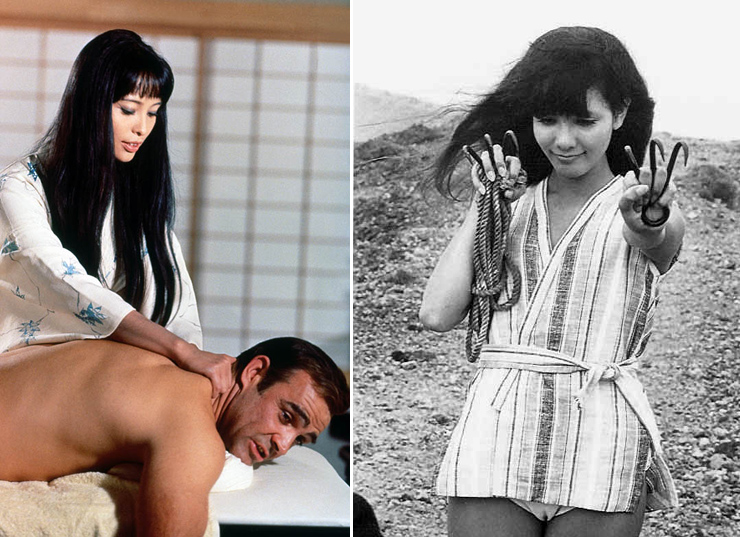
As for Wakabayashi, her list of post-You Only Live Twice credits
extends to just one film and one TV series – a consequence, it appears, of
injury, as well as the desire for a quieter life.
“I had injuries in some movies and TV shows,” she told Vaquer and Homenick.
“Some bones suffered damage. It didn't look serious because nobody saw
anything from outside, but it was very painful. Now I enjoy a slow-paced
life while helping my partner (an actor). I want more of a simple and
slow-paced life.”
When this writer travelled to Japan in 2013 I hoped to track down both
women and interview them for 007 MAGAZINE about their lives and careers
pre and post-007, as well as hear their insights about their experiences
filming You Only Live Twice and dealing with the maelstrom of media
attention that followed, the 60s spy craze and Bond-mania.
Having interviewed, with few obstacles and wholehearted co-operation, many
actresses from the world of 007 already – including Luciana Paluzzi,
Shirley Eaton, Martine Beswicke, Margaret Nolan and Caroline Munro – I was
perhaps naïve in thinking that I could add Hama and Wakabayashi to this
illustrious roll call.
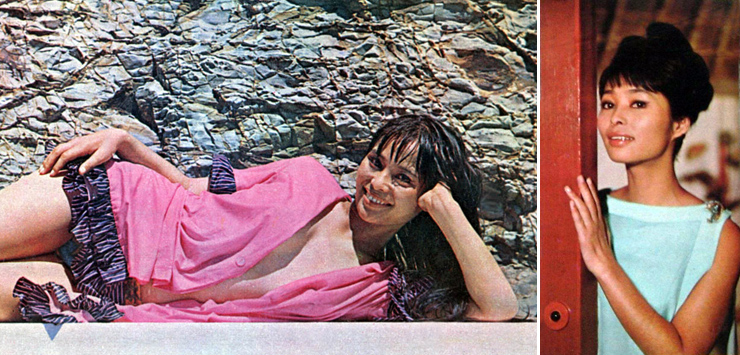
Prior to arriving in Japan I failed to find so much as a single contact
that could pass on an interview request to Wakabayashi, whose whereabouts
seemed a complete mystery to any one I talked to within the 007 industry
and fan community.
As for Hama, I was able to make a request, via an email address on her
personal website, for an interview, only to be informed by one of her
managers, Shin Kaneko (also her son), that during the days I was in Tokyo
and Kyoto she would be on summer vacation in Okinawa.
In typically polite Japanese fashion Kaneko told me “we appreciate your
interest”, but my follow-up suggestion of an email interview went
unanswered.
One man who I later discovered had met both women was former Bond
continuation author Raymond Benson, during a research visit to Japan in
2001.
Earlier this year, Benson informed me that he no longer had any way of
contacting either woman. He was also kind enough to share his memories of
meeting the two ladies with 007 MAGAZINE, telling me via email:
"I met both Akiko Wakabayashi and Mie Hama in the year 2001 when I was in
Japan researching my [sixth] Bond novel, THE MAN WITH THE RED TATTOO.”
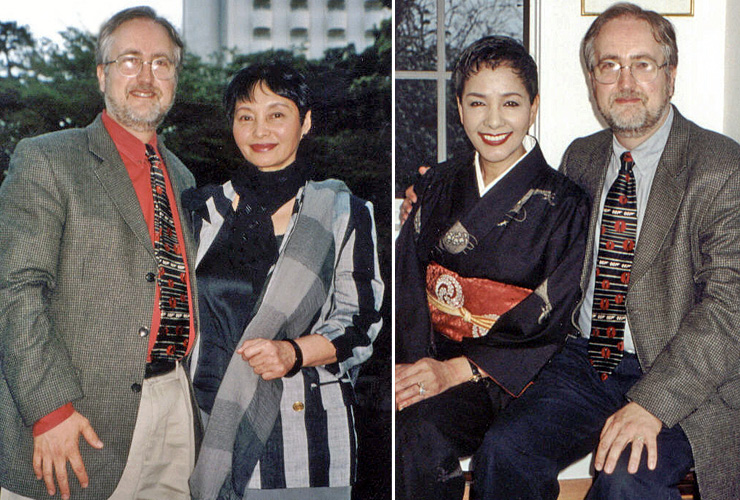
“The meetings were arranged by a mutual acquaintance in Japan. Ms.
Wakabayashi was very pleasant; my guide and I spent a couple of hours
talking with her about her career and experience on You Only Live Twice.
We met at a restaurant, if I remember correctly, and then we took a stroll
through a park. She had retreated from the public eye many years earlier
and was enjoying her anonymity.
“Ms. Hama was very gracious and invited me and my guide to dinner at her
house. She was very friendly and talkative, and the dinner she served –
Italian! – was on the menu of her personal ‘restaurant’ that was a part of
her home. Patrons had to make reservations to dine there, and she served
only a small party at a time. She, too, talked about her experience on the
Bond film, but as you know, she had a long career in Japan afterwards as a
film star, television personality, and author. Both ladies were still
beautiful."
As Benson’s account suggests, both ladies prefer to largely keep their own
counsel and remain detached from the media circus that often surrounds the
Bond movies and the treadmill of conventions and autograph shows.
The full reasons for their decisions, of course, remain private and truly
known only to Hama and Wakabayashi themselves.
Over the years, from many different sources here and in Japan, I have
heard various rumours – for example, that both women have been ‘burned’ by
their experiences with previous autograph hunters, fans and journalists.
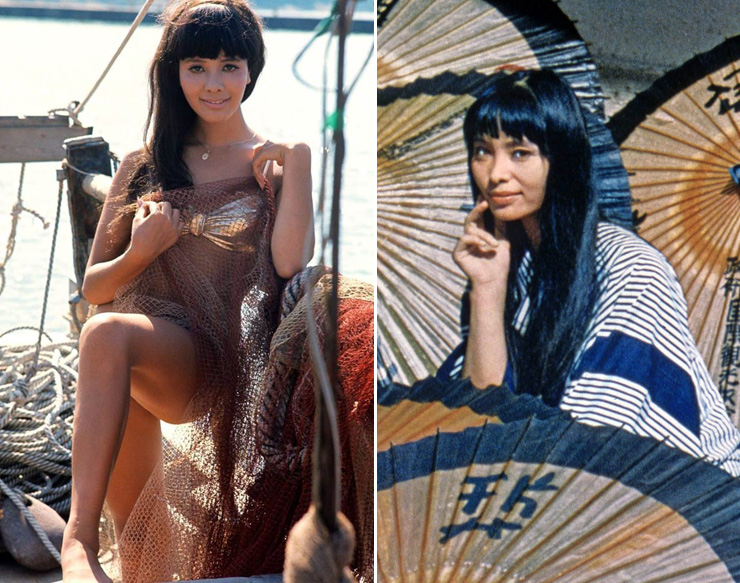
Others have theorised that, like many artists connected with the Bond
series, they have found the interest the films generate, and the long
shadow involvement with 007 casts, to be somewhat disorientating.
An interesting further perspective was provided in a 2014 interview by
Brett Homenick with Japanese actor Tatsuyoshi Ehara, who appeared in
several ‘Toho’ films with Mie Hama.
“I sometimes see [former co-stars] Ms. Yuriko Hoshi and Ms. Nami Tamura,
but I never see Ms. Hama,” he recalled. “I worked with Ms. Hama on three
movies, and we went on location in Oshima for a commercial.
“She used to be a bus girl, and she was scouted for Toho and joined the
studio, but being an actress was just one step in her life. So, after she
got married and lived in the countryside, she never made public
appearances.
“She was famous for her role in a 007 movie, but in those days people had
a prejudice against that kind of movie. The actresses in those films were
almost naked, so it was almost like a Nikkatsu role. Some people said she
should have gone into Nikkatsu. Nikkatsu specialized in a certain genre,
and Nikkatsu sounds like “nikku katsu,” and “niku” is “meat” or “body”!”
Given the Japanese tendency towards public prudishness, and the two
ladies’ appearance in the 1967 PLAYBOY pictorial 007’s Oriental Eyefuls
(albeit pretty modest appearances), it would be understandable if Hama and
Wakabayashi perhaps regard their decorative status in a 007 film as
somewhat embarrassing.
In the final analysis, though, such speculation is somewhat pointless.
During the long research and gestation period of writing this article, I
have come to the realisation that Bond fans often treat the 007 films as
their own personal property, and this sense of propriety often extends to
those artists who were involved with the films, both in front of and
behind the cameras.
Many fans seem to harbour the view that those involved in the Bond films
have some form of ‘responsibility’ to the fans or the series in terms of
making themselves available for interviews, conventions, autographs or
photo opportunities.

I would now argue the opposite case. If someone is appearing at a
convention or an autograph show then clearly they have decided to engage
with the rules of the ‘fan game’, but I think it should be emphasised that
this should always be a matter of personal choice.
The opposing choice, and wishes, of more private artists, such as Hama and
Wakabayashi should also be respected.
Although she recorded a pair of DVD commentaries in Japan in 2001 and
2005, Akiko Wakabayashi has made no further public comment on her career
since she told Vaquer and Homenick in 2006:
“I am very grateful to those who remain to be my fans long after I
retired. I love movies because they amuse me and make me think about many
things. I'm interested in staff as well as cast. Movies, both old and new,
are my friends in life.”
As for Mie Hama, feeling somewhat guilty for my impudent Western
persistence, I made one further effort to interview her earlier this year,
receiving this reply from Shin Kaneko, which for me brought a sense of
closure to the matter:
“I sincerely thank your offer again. Both Mie and I realise that this year
is a big year for You Only Live Twice. Mie told me that she ended
her career as an actress more than 30 years ago and now she wants to keep
that good memory as a Bond girl in her mind. She’s 73 years old now and
she’s trying to keep a distance from the mainstream of the movie industry
and enjoying her quiet life in suburb area of Japan. Therefore, I’m sorry
but I may have to decline your offer. Truly sorry for that.”
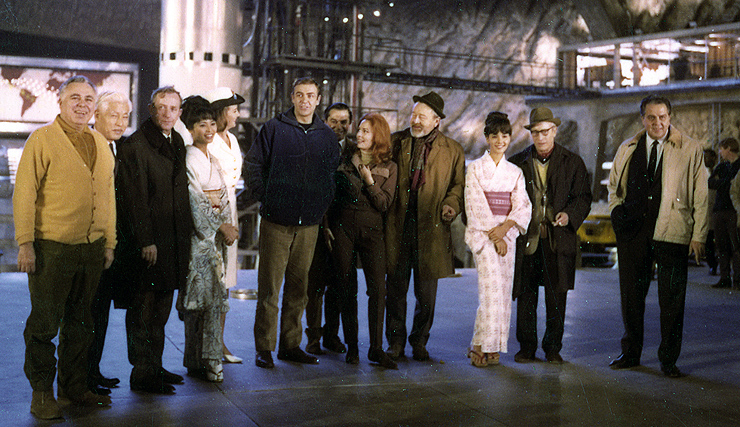 |
|
ABOVE: Cast and crew
of You Only Live Twice gather on Ken Adam's superb volcano
set at Pinewood Studios in 1966 [L-R] Producer Harry Saltzman,
Teru Shimada (Mr Osato), Director Lewis Gilbert, Akiko Wakabayashi
(Aki), Lois Maxwell (Miss Moneypenny), Sean Connery (James Bond),
Production Designer Ken Adam, Karin Dor (Helga Brandt), Jan Werich
[the actor originally cast as Ernst Stavro Blofeld and replaced in
the final film by Donald Pleasence], Mie Hama (Kissy Suzuki),
Director of Photography Freddie Young, and Producer Albert R.
‘Cubby’ Broccoli. |
|
“I told your request to her and she sincerely thanks [you] for that. But I
hope you’ll understand the situation and respect her decision.”
“Thank you again for all the support and long lasting love for the movie.
She send her regards to you as well.”
Although Hama and Wakabayashi’s public comments and appearances have been
few and far between, their place in Bond history is forever assured.
Ian Fleming’s Kissy Suzuki forsook life in Hollywood for a return to the
island of Kuro – and in a case of life imitating art – Hama and
Wakabayashi’s journey has also, it seems, concluded with them finding
comfort and peace at home, in Japan.
As Matsuo Basho – the master of the Haiku - once observed: “Every day is a
journey, and the journey itself is home.”
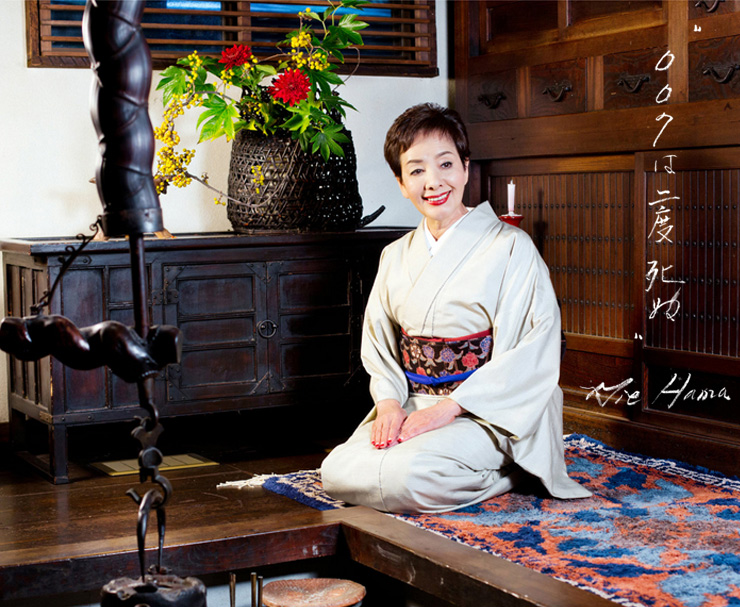 |